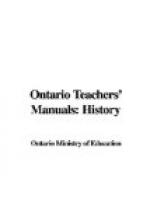(a)
Routes that were possible
(b)
Reasons for the final choice
4. Facts about the road
(a)
Principal places on the road
(b)
Branches of the road
(c)
Length and cost
5. Value of the road to the new Dominion
The class may be asked afterwards to draw a map showing the route and the chief commercial centres served by the railway.
INDUSTRIAL REVOLUTION IN ENGLAND, 1760-1800.
NOTE.—This lesson should be preceded by an information lesson on the making of cotton goods—the material, how and where the raw material is grown, how it is harvested, the difference between spinning and weaving, the meaning of warp and woof.
The aim of this lesson is to show how a remarkable series of inventions changed completely the processes of manufacturing, made England the greatest manufacturing nation in the world, and gave her a source of wealth that enabled her to carry on the costly wars against Napoleon. The half century of this revolution is one of the most important in English history, on account of the results in methods of transportation, in agriculture, in social conditions, etc., and it is almost impossible to have a satisfactory knowledge of succeeding history without understanding this period. It is for this reason that it is treated at such length.
This may be divided into as many lessons as the teacher wishes. The dates given are not intended to be memorized by the pupils; they are introduced simply to emphasize the order of the inventions. To emphasize further the sequence, the class may be asked at each step what invention would be needed next. The oral method—both pure narrative, and development—is supposed to be used.
1. Domestic System of Manufacture.—Before 1760 the manufacture of cotton goods was carried on in the homes of the people. A spinner would procure a supply of raw cotton from the dealer and carry it home, where, with the help of his family, he would spin it into threads or yarn and return it to the dealer. The spinning was all done by hand or foot-power on a wheel that required one person to run it, and that would make only one thread at a time. The weaving was also done at home. Because of the use of Kay’s flying shuttle (1732), the demand of the weavers for yarn was greater than the spinners could supply, because one weaver could use the product of many spinners, and there was great need of finding some way of producing yarn more rapidly, to keep the weavers busy.




